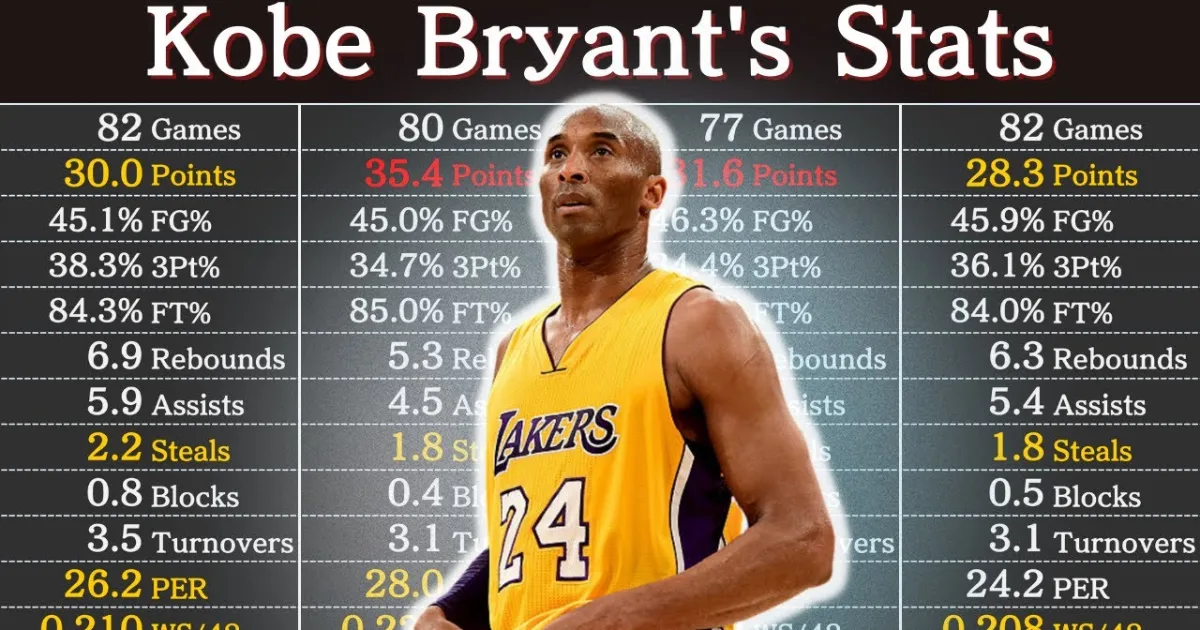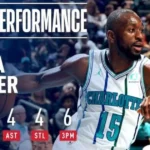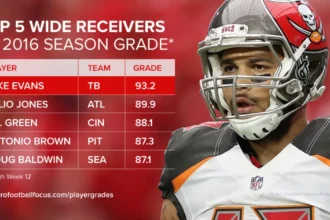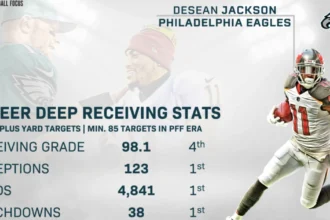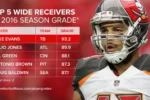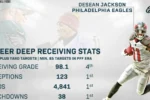Hey there, basketball fans! If you’re anything like me, Kobe Bryant Career Stats name still sends chills down your spine. The guy wasn’t just a player—he was a force of nature, a storyteller on the court who turned every dribble into drama. From his jaw-dropping dunks as a teenager to those clutch shots in the Finals, Kobe’s career is the stuff of hoops legend. Today, we’re talking all about his career stats. I’ll break it down in a way that’s super easy to follow, whether you’re a die-hard Lakers fan reliving the glory days or a young baller just discovering why everyone calls him the Black Mamba.
We’ll start with a quick look at his journey, then dive into the numbers with a full table of his season-by-season stats. After that, we’ll unpack the key highlights, compare regular season to playoffs, and chat about what those numbers really mean. Grab a snack, settle in—this is going to be a fun ride through 20 years of pure basketball magic. Let’s go!
The Early Days: From High School Phenom to Lakers Rookie
Picture this: It’s 1996, and a 17-year-old kid from Philly is skipping college to jump straight into the NBA Draft. That’s Kobe Bryant, selected 13th overall by the Charlotte Hornets and immediately traded to the Los Angeles Lakers. Why? Because the Lakers saw a diamond in the rough—a 6’6″ shooting guard with Michael Jordan’s footwork and a work ethic that could outpace a freight train.
Kobe’s rookie year (1996-97) was all about learning the ropes. He barely played—averaging just 15.5 minutes per game—but when he did, oh boy. He dropped 81 points in a single game years later, but back then, it was flashes: a poster dunk here, a steal there. By his second season, he was starting, and the stats started climbing. Teamed up with Shaquille O’Neal in 1999, the duo became unstoppable, winning three straight championships from 2000 to 2002. Kobe’s scoring exploded, and so did his reputation as a clutch performer.
But it wasn’t all smooth. Conflicts with Shaq led to drama, and after the Lakers’ 2004 Finals loss, Kobe became the alpha. He carried the team on his back through tough years, peaking with two more rings in 2009 and 2010. Later, injuries slowed him down, but even in his final 2016 season, he went out with a bang—60 points in his last game. Kobe retired with five championships, 18 All-Star nods, and a Hall of Fame induction in 2020. His stats? They’re the blueprint for what it means to be a superstar. Now, let’s get to the good stuff.
Kobe’s Season-by-Season Stats: The Full Breakdown
To really appreciate Kobe’s evolution, you need to see the numbers year by year. Below is a comprehensive table of his regular season career stats. I’ve kept it simple: games played (GP), minutes per game (MPG), field goal percentage (FG%), three-point percentage (3P%), free throw percentage (FT%), rebounds per game (RPG), assists per game (APG), steals per game (SPG), blocks per game (BPG), and points per game (PPG). These are the core metrics that tell the tale of his scoring prowess and all-around game.
This table is pulled from reliable NBA records, showing how Kobe adapted—from a raw rookie to an efficient veteran. Notice how his minutes ramp up in the early 2000s, and his scoring peaks during those solo hero years?
| Season | GP | MPG | FG% | 3P% | FT% | RPG | APG | SPG | BPG | PPG |
|---|---|---|---|---|---|---|---|---|---|---|
| 1996-97 | 6 | 6.0 | .375 | .000 | .000 | 0.8 | 0.5 | 0.3 | 0.0 | 1.7 |
| 1997-98 | 79 | 27.8 | .428 | .189 | .755 | 2.5 | 2.4 | 1.2 | 0.5 | 15.4 |
| 1998-99 | 50 | 37.9 | .463 | .267 | .836 | 4.9 | 3.8 | 1.7 | 0.9 | 19.9 |
| 1999-00 | 66 | 38.9 | .468 | .319 | .821 | 4.7 | 3.9 | 1.6 | 0.5 | 22.5 |
| 2000-01 | 68 | 40.1 | .464 | .305 | .828 | 4.9 | 3.7 | 1.7 | 0.3 | 28.5 |
| 2001-02 | 80 | 38.1 | .469 | .290 | .839 | 5.5 | 4.2 | 1.5 | 0.4 | 25.2 |
| 2002-03 | 80 | 41.3 | .430 | .383 | .840 | 6.9 | 5.9 | 2.2 | 0.4 | 30.0 |
| 2003-04 | 80 | 38.2 | .437 | .351 | .852 | 5.5 | 5.1 | 1.6 | 0.4 | 24.0 |
| 2004-05 | 66 | 40.7 | .456 | .333 | .843 | 5.9 | 4.7 | 1.6 | 0.3 | 35.4 |
| 2005-06 | 80 | 41.0 | .450 | .347 | .850 | 5.3 | 4.5 | 1.8 | 0.4 | 35.4 |
| 2006-07 | 77 | 40.8 | .462 | .344 | .833 | 5.7 | 5.4 | 1.4 | 0.5 | 31.6 |
| 2007-08 | 82 | 36.8 | .459 | .361 | .830 | 6.3 | 5.4 | 1.7 | 0.5 | 28.3 |
| 2008-09 | 82 | 36.2 | .456 | .353 | .856 | 5.7 | 4.9 | 1.3 | 0.4 | 26.8 |
| 2009-10 | 73 | 36.2 | .456 | .320 | .818 | 5.4 | 5.0 | 1.4 | 0.3 | 27.0 |
| 2010-11 | 82 | 33.9 | .450 | .327 | .828 | 5.1 | 4.7 | 1.2 | 0.2 | 25.3 |
| 2011-12 | 58 | 33.9 | .430 | .300 | .845 | 5.4 | 4.6 | 1.2 | 0.3 | 27.9 |
| 2012-13 | 78 | 38.6 | .446 | .386 | .840 | 6.0 | 6.0 | 1.4 | 0.4 | 27.3 |
| 2013-14 | 6 | 30.3 | .416 | .188 | .889 | 6.3 | 5.8 | 0.8 | 0.2 | 17.6 |
| 2014-15 | 35 | 34.5 | .416 | .286 | .814 | 6.6 | 5.6 | 1.2 | 0.3 | 22.3 |
| 2015-16 | 66 | 30.3 | .359 | .285 | .837 | 5.7 | 4.9 | 1.4 | 0.2 | 17.6 |
| Career | 1346 | 36.1 | .447 | .329 | .837 | 5.2 | 4.7 | 1.4 | .4 | 25.0 |
(Data sourced from official NBA records via Basketball-Reference.com)
There you have it—Kobe’s statistical roadmap. See how his PPG skyrockets to 35.4 in 2004-05 and 2005-06? That’s when he was dropping 81 on the Raptors and averaging over 40 in stretches. His assists peak in 2002-03 at 5.9, showing he could run the show too. And those steals? Consistently over 1.4, proving he was a defensive pest. This table isn’t just numbers; it’s the heartbeat of a career built on grit.
Regular Season Deep Dive: Scoring Machine Meets All-Around Star
Kobe’s regular season stats paint him as the ultimate offensive dynamo. Career averages: 25.0 points per game over 1,346 games. That’s fourth all-time in scoring, behind only LeBron James, Karl Malone, and Kareem Abdul-Jabbar. But let’s break it down.
Points Galore: Kobe scored 33,643 points in his career—insane volume. His efficiency? A 44.7% field goal clip isn’t elite by today’s standards, but remember, he took tough shots: fades, off-balance threes, and acrobatic layups. His three-point shooting hovered at 32.9%, improving to 38.6% in 2012-13 when he embraced the arc more. Free throws? 83.7% on 8,378 attempts. The man lived at the line, earning “Hack-a-Kobe” its name.
Beyond Scoring: Don’t sleep on his playmaking—4.7 assists per game. In 2012-13, he hit 6.0, dishing like a point guard. Rebounds? 5.2 per game, with a high of 6.9 in 2002-03. Defensively, 1.4 steals and 0.4 blocks show he disrupted plays without gambling too much. His PER (Player Efficiency Rating) of 22.9 screams superstar, and 172.7 win shares? That’s impact.
Season highlights? The 2005-06 MVP year: 35.4 PPG on 45.0% shooting. Or 2002-03, his first 30 PPG season. Even in decline, post-2013 injuries, he adapted—fewer minutes, smarter shots. Kobe’s regular season was about consistency: 15 straight 20+ PPG seasons, eight scoring titles (tied for second all-time). He wasn’t just a scorer; he was the engine that made the Lakers roar.
Playoff Stats: Where the Black Mamba Really Bit
If regular season Kobe was a lion, playoff Kobe was a shark—relentless, adapting to pressure. Over 220 playoff games (third all-time), he averaged 25.6 PPG, 5.1 RPG, 4.7 APG, 1.4 SPG, and 0.7 BPG. Shooting: 44.8% FG, 33.1% 3P, 81.6% FT. Total playoff points: 5,640.
Here’s a quick comparison table to see how he elevated:
| Category | Regular Season Avg | Playoff Avg | Difference |
|---|---|---|---|
| PPG | 25.0 | 25.6 | +0.6 |
| RPG | 5.2 | 5.1 | -0.1 |
| APG | 4.7 | 4.7 | Even |
| SPG | 1.4 | 1.4 | Even |
| FG% | 44.7% | 44.8% | +0.1% |
(Data from Land of Basketball and Basketball-Reference)
Slight uptick in scoring, same defensive intensity—Kobe thrived in May and June. His crowning jewel? The 2009 and 2010 Finals, where he averaged 32.4 and 28.6 PPG, respectively, clinching rings without Shaq. In 2001, he dropped 35.0 PPG in a series against Portland. Career playoff high: 45 points in Game 7 vs. Phoenix in 2010.
But it’s the intangibles: 15 All-Defensive nods, two Finals MVPs. Kobe’s playoffs were 5-4 in series wins, but every loss felt like fuel. He played through fractures, sprains—whatever. Those stats? They won titles.
Career Totals and Milestones: Numbers That Echo Forever
Let’s stack up the totals. Regular season: 33,643 points (4th all-time), 6,922 rebounds, 6,306 assists, 1,944 steals, 640 blocks. Playoffs add 5,640 points, 1,119 rebounds, 1,040 assists. Combined? Over 39,000 points—legendary territory.
Milestones galore: 81-point game (2006), most 60+ point games (6), 30,000 points club. All-Star MVP three times. Scoring titles from 2006-07. His 2016 farewell? 60 points on 50 shots—poetic chaos.
What do these totals say? Kobe wasn’t efficient like Steph Curry, but he was durable—played 80+ games eight times. His 48.2% eFG (effective FG%) accounts for volume. Advanced stats love him: 22.9 PER, 7th in VORP (Value Over Replacement Player). Bottom line: These numbers built a dynasty and inspired millions.
The Advanced Side: Efficiency, Impact, and What It All Means
Dig a little deeper, and Kobe’s stats reveal a thinker. True Shooting % (TS%) career: 55.3%—solid for a high-usage guy (34.2% usage rate). In playoffs, it dipped slightly to 54.8%, but he won anyway. Win shares per 48 minutes: .172—elite.
For kids reading this: Kobe teaches volume matters, but so does heart. His turnovers (3.7 per game career) show risk-taking, but 4.7 assists balance it. For older fans: Compare to Jordan—Kobe’s 25.0 PPG edges MJ’s 30.1 but over more games. Efficiency? MJ wins, but Kobe faced zones and hands.
In today’s analytics world, Kobe might’ve shot more threes earlier. But his era? He dominated it. Those stats aren’t cold data—they’re stories of 4 a.m. workouts, trash-talked rivals, and “Mamba Mentality.”
Legacy Beyond the Numbers: Why Kobe’s Stats Still Inspire
Kobe Bryant Career Stats passed in 2020, but his stats live on as blueprints. Young players study his footwork via those 35.4 PPG seasons. Coaches cite his 5.9 APG peaks for balance. And fans? We remember the 81, the fades, the rings.

